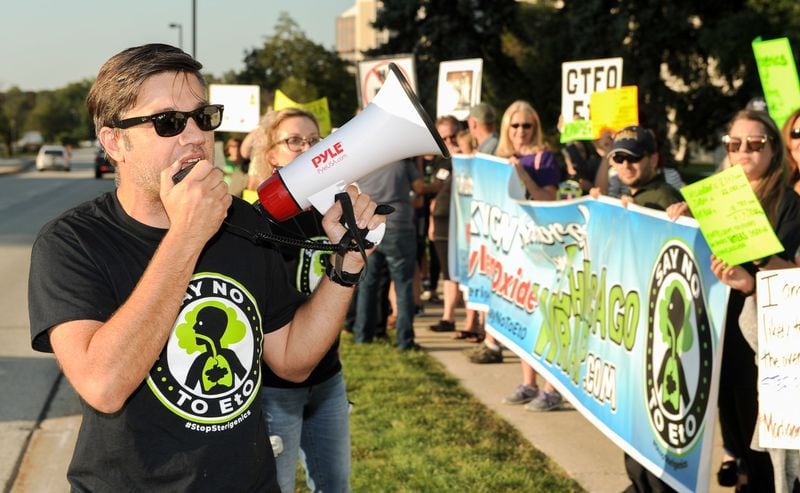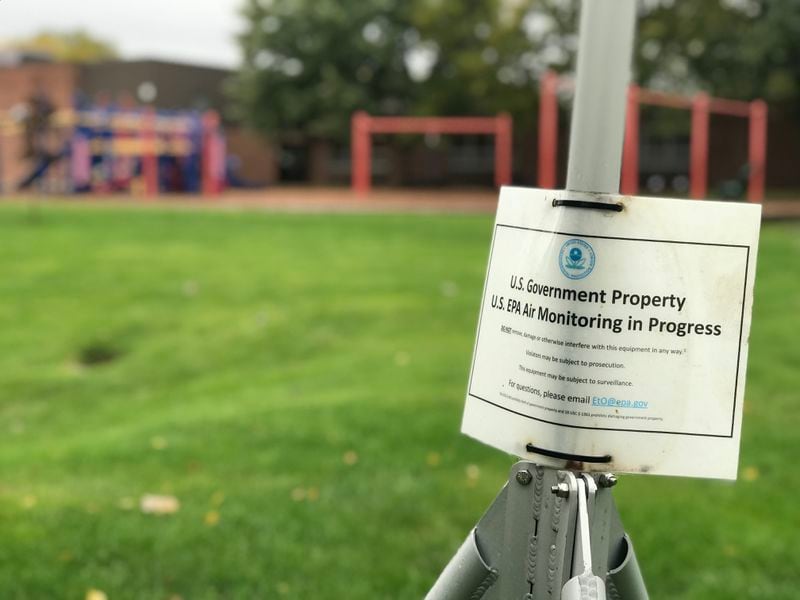WILLOWBROOK, IL. — Mayor Frank Trilla used to think of his village as the "best kept secret" in Chicagoland, beloved by residents for its small town appeal with easy access to the city and its two airports.
“I used to go to meetings and no one ever knew where Willowbrook was,” Trilla recalled.
That was before the mayor received a letter in August 2018 alerting him to elevated cancer risk due to permitted emissions from a local plant operated by Sterigenics.
Over the next year, the issue sparked angry protests, roiled elections and shined a national spotlight on the village of 9,000 as the face of a growing grassroots movement to crack down on the use of ethylene oxide, a carcinogenic gas used in sterilization and manufacturing.
In Georgia, activists are following Willowbrook's example in their efforts to have a similar facility in Cobb County shut down.
Trilla recently declared victory over Sterigenics when the company announced it would not resume operations in Illinois, citing regulatory uncertainty. But the battle has left scars on the community, the mayor said, and people today have a very different reaction to Willowbrook.
“They know exactly where it is, and they associate it immediately with this,” Trilla said, gesturing to the stack of newspaper reports about Sterigenics he’s collected in a box behind his desk. “So we’ve got some repair work to do.”
Most Georgians remained blissfully unaware of the controversy over ethylene oxide until recently, when reporting by Georgia Health News and WebMD revealed several hot spots for potential elevated cancer risk, including around the Sterigenics facility in Cobb. Ethylene oxide is used legally by Sterigenics at its facility near Smyrna to sterilize single-use medical devices such as syringes and catheters. The facility in Willowbrook was larger than the Cobb plant, and also sterilized medical products.
Ethylene oxide has been used as a sterilizer for decades. But the chemical has come under increased scrutiny since the government classified it as a carcinogen in 2016 and concluded it was toxic at much lower levels than previously thought. This revised risk assessment followed years of study and extensive vetting at the federal level.
A Sterigenics spokesman said the company has nearly completed installing “state-of-the-art” improvements to its facility near Smyrna that “will further reduce our emissions beyond already safe levels.”
“The Atlanta facility is safe and does not harm public health,” the spokesman said. “We are committed to continuing to work with state and local officials to complete these enhancements and resume operations to provide patients with vital sterilized medical products and devices.”
In Georgia, activists are now calling for Sterigenics in Cobb County to close permanently, and Willowbrook residents are offering expertise, resources and encouragement.
Janet Rau, president of Stop Sterigenics Georgia, said the support of Willowbrook activists was pivotal to what she sees as her organization’s early success in Georgia. In the past several months, the Cobb plant has suspended operations indefinitely, the state has committed to air monitoring, and local and state officials are discussing potential new regulations.
“I think all of that has happened on the shoulders of the folks up in Willowbrook,” Rau said. But, she added, “It’s going to be a roller coaster.”
“I’m under no illusions that this is going to be over quickly,” Rau said. “I think there are a lot of people in our community who think, ‘Yay! They’ve shut down! We won!’ and, it’s like, no. Legislative action takes a very long time, and legal action takes time.”
In fact, the company has already indicated that it won’t be dispatched easily.
Last week, Sterigenics sent a letter to Cobb officials threatening legal action over the county’s regulation of the facility’s permitting and building occupancy, which threatens to block it from reopening. The letter says the county is causing the company “irreparable harm.”
‘How does a community win?’
Many Willowbrook residents are relieved to see Sterigenics go.
The Atlanta Journal-Constitution recently met with more than a dozen activists, residents, students and local officials at the center of the community’s fight against the company, and they say the ordeal brought the town and its neighbors closer.
But they view the work as unfinished. And the recent win can’t erase the pain of the past, especially for families who have suffered illness or lost loved ones to cancer that they believe was caused by exposure to ethylene oxide.
A study by the Illinois Department of Public Health found an increased incidence of cancer surrounding Sterigenics, particularly among women and girls. The plant had been operating there since the 1980s.
“We lost so much already,” said Joanna Chlystek, who lives in Darien, about a mile from the plant. “How does a community like ours win?”
The company has said repeatedly that there are many sources of ethylene oxide.
In August 2018, Mayor Trilla was a part-time mayor with a family car wash business. He knew nothing of ethylene oxide or what, exactly, the Sterigenics plant across the street from Village Hall did — other than tear up the road with heavy trucks.
Then he received a letter addressed to the local Air and Radiation Division of the federal Environmental Protection Agency.
The document was a health risk assessment from the Agency for Toxic Substances and Disease Registry, based on air samples taken around the Sterigenics facility in Willowbrook.
The findings alarmed Trilla. It estimated cancer risk as high as 6,400 cancer cases per million people that would not otherwise develop but for the presence of the chemical. Federal regulators consider anything above 100 extra cancers per million people an unacceptable risk.
“If these measured and estimated concentrations represent chronic exposures in the surrounding community … emissions from the Sterigenics Corporation pose a public health hazard,” it read.
The letter arrived around the same time the federal EPA released its 2018 National Air Toxics Assessment report, which flagged more than a hundred census tracts across the country for potential elevated cancer risks from ethylene oxide, including the areas around Sterigenics’ plants in Illinois and Georgia.
Within a few weeks, the village of Willowbrook had formed a task force, organized a town hall and sent a letter to Sterigenics asking the company to cease operations.
Meanwhile, residents began organizing and sharing information under the banner Stop Sterigenics. Many said they discovered they shared similar chronic health issues and what seemed like an unusual number of cancers. A core group of about a dozen people, many of them educated professionals with young families, took the lead on research and outreach, going door to door to raise awareness and holding community events.
“For each of us individually, it started with stories at home,” said Willowbrook resident Sri Rao. “It kind of just kept adding fuel and fuel and fuel, the more people you talked to.”
‘Roadblocks and non-interest’
Not everyone shared Stop Sterigenics’ point of view. And there was backlash.
Some accused the activists of exaggerating the risk, and damaging property values as a result. Others dismissed it as a partisan ploy, especially after press reports revealed then-governor Bruce Rauner, a Republican, had financial ties to the company.
Willowbrook is located in DuPage County, the traditional seat of the Republican Party in Illinois, which was becoming increasingly competitive for Democrats. The company and its emissions quickly became a lightning rod issue in a number of highly contested elections, including the governor’s race.
In October 2018, Democratic gubernatorial candidate J.B. Pritzker released a campaign ad highlighting Rauner's financial interest in Sterigenics and slamming his response to community concerns. Rauner would lose his seat to Pritzker several weeks later.
Republican State Sen. John Curran, an early supporter of Stop Sterigenics, said that while partisanship may have been a dividing factor early on, it soon became clear that concern cut across party lines.
“Once the election occurred, partisanship on the issue completely went away,” said Curran, who won re-election that November and went on to sponsor bipartisan legislation on ethylene oxide that he touts as the strictest in the nation.
Popular support for Stop Sterigenics also grew as more air monitoring test results found elevated ethylene oxide levels throughout the community.
Then, in February, Willowbrook published its highest readings yet: A sample from the elementary school showed ethylene oxide concentrations 155 times higher than the federal EPA's screening threshold for cancer risk; another from the middle school was 306 times higher; and the police station across the street from the facility had levels more than 10,000 times higher.
As a result of those readings, the state environmental agency issued a seal order closing the facility.
“The modeling that was being used regarding ethylene oxide emissions from Sterigenics was faulty, and in fact (the plant) was producing a much higher rate of ethylene oxide than previously believed,” Sen. Curran said. “We know it was from Sterigenics because we turned the emission off and it dropped immediately and dramatically.”
The company called the state’s shutdown of the plant “indefensible” and said it “consistently complied with all state permits and regulations.” It said the state was setting a “dangerous precedent.”
Despite reaching a deal with the state to reopen, Sterigenics announced last month it would not resume operations in Willowbrook.
Sen. Curran said the closure was not inevitable. He said elected officials tried to work with the company, but were met with “roadblocks and non-interest.”
“Once I saw that from the company — that they didn’t want to actively participate in dealing with this issue — that’s when I realized this was going to take government intervention,” the senator said.
The Sterigenics’ spokesman disputed that characterization. He said company officials “worked for months to seek a constructive solution” and had a “path to reopen.” But, he said, “the unstable legislative and regulatory landscape prevented us from reaching an agreement to renew our lease and created circumstances in which it was not reasonable to continue operations.”
Ethylene oxide in Georgia
In Georgia, the topic is just heating up. This week, lawmakers from Cobb and Fulton met to discuss Sterigenics, while Students Against Ethylene Oxide in Illinois are planning their own conference call with counterparts in Cobb.
Rau, the president of Stop Sterigenics Georgia, said so far the effort is bipartisan, but she expects it could play a role in upcoming elections — especially for incumbents seen as unresponsive.
As for Sterigenics itself, she said the company appears to be using the same playbook it deployed in Illinois, by sowing doubt in the science behind the health impacts of ethylene oxide and the government’s risk assessments. She expressed concern that the company was attempting to bypass pressure from grassroots organizations by lobbying politicians in Washington.
“We have 5,000 people in our group,” Rau said. “Five thousand matters when you’re talking about Cobb County, but when you’re talking about the federal level, that’s a drop in the bucket.”
The EPA, which was expected to issue new regulation for ethylene oxide this summer, recently announced it was delaying those rules as it seeks more input.
When asked if the company was focusing its regulatory negotiations in Washington, the Sterigenics spokesman said “nothing could be further from the truth.”
“Sterigenics has dedicated significant resources to providing needed information for all members of the public,” the spokesman said. He added that company officials are engaging with political leaders at the state and local levels, and has provided tours of the facility to residents and local representatives.
In Willowbrook, activists are still pushing for more regulation from the state of Illinois. Lawmakers there recently held a hearing on two proposals — one that would empower homerule municipalities to ban ethylene oxide, and the other that would phase out the use of the chemical in sterilization completely.
Mayor Trilla, for his part, says he’s eager to move on. But first he has to assess the damage.
With an annual budget of about $8 million, Willowbrook has spent an unexpected $800,000 on air testing, lawyers and manpower to fight Sterigenics. That meant renovations on the new Village Hall were halted, as well as a plan to address police pensions.
In addition, local real estate values have taken a hit. And many residents speak of the “trauma” of the past year that continues to haunt them.
“We’ve got to get back on the positive image and, you know, getting everybody back to feeling proud of their town,” said the mayor, who has big plans for the annual Christmas festival. “We’ll be glad to see a new year.”










